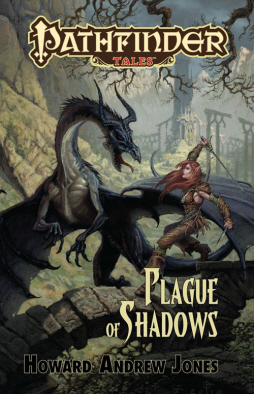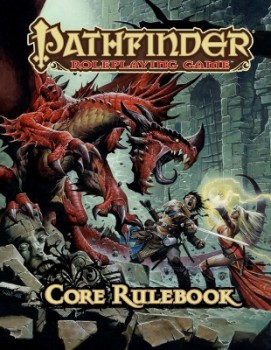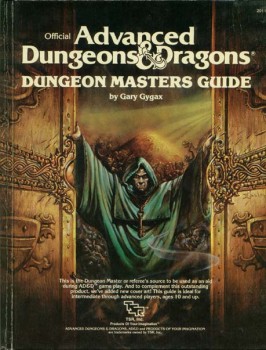Black Gate Interviews Howard Andrew Jones, Part Three
 In part one of our interview Howard talked about one of his new novels, The Desert of Souls, and about historical fantasy; in part two we discussed the works of Harold Lamb and Howard’s efforts to collect and republish Lamb’s fiction; for our third and final installment Howard tells us about yet another newly released novel, and his experience with gaming:
In part one of our interview Howard talked about one of his new novels, The Desert of Souls, and about historical fantasy; in part two we discussed the works of Harold Lamb and Howard’s efforts to collect and republish Lamb’s fiction; for our third and final installment Howard tells us about yet another newly released novel, and his experience with gaming:
We’ve talked about historical fiction and historical fantasy, but you also have a history with gaming. Tell us a bit about your new Pathfinder novel, Plague of Shadows.
James Sutter, the editor of the Pathfinder line, is pretty selective about what he buys, so when I was invited to submit ideas I had to throw several his way before one finally took. I think the line in the pitch that hooked him was “Jirel of Joiry crossed with Unforgiven.” I made it clear that I wasn’t going to lift the plot or character, but that I was going to strive for a similar feel. As for the subject matter, I think that James described it pretty well in a blurb he posted recently: “It revolves around the exploits of not one but two bands of adventurers journeying in eastern Avistan, two decades apart. The parties are connected by Elyana, an elf seeking to cure her former adventuring partner (and former lover) Stelan from a curse that’s connected to events — and people — from their shadowy past. Elyana’s journey will take her and her companions from Taldor to Galt, into Kyonin and to the Vale of Shadows, where the consequences of events decades before will affect Stelan’s future.”
I wanted a story that started out with a linear feel so that it could move forward with momentum, then added complications as the adventure got under way. I think there are some nice character moments and well-motivated, though unexpected, plot turns. Personality wise Elyana didn’t end up being a Jirel of Joiry knock-off, although she’s definitely a kick butt protagonist, so she has that in common with the famous character. She’s also seasoned and clever, and she’s relentless — she simply never gives up. I had a lot of fun writing her.
How much did you know about the Pathfinder world before you began work on the novel? What would you say are the differences between developing a fantasy completely on your own, versus working in a world with a great deal of background already filled in.
I’d been doing some reading about Golarion for a review I was working on for Black Gate, and I’d been reading Paizo products for other reviews for years, so it wasn’t completely unfamiliar territory. But reading to get a sense of the place and reading to FIND a place to set the scenes proved to be two different things.
Working in a setting devised by someone else is a little like researching for historical fiction except that you can consult the creators yourself. There was also a great deal of freedom to improvise, with the caveat that everything still had to be approved by said creators. While there were certainly a lot of detailed spaces, there were empty spots on the map, and I was allowed a great deal of freedom to drop things in there and add information to the cultures in question.
 And not just writing in another world, but writing in a world that is actually used by thousands of people to experience their own adventures. How do you make sure you’ve satisfied the demands and expectations of this very specific audience? Were there things you had to do differently for your Pathfinder story versus your Dabir and Asim novel?
And not just writing in another world, but writing in a world that is actually used by thousands of people to experience their own adventures. How do you make sure you’ve satisfied the demands and expectations of this very specific audience? Were there things you had to do differently for your Pathfinder story versus your Dabir and Asim novel?
On some levels writing adventure fiction is the same, whether it is for a game or not. You have to tell a compelling story that features interesting characters. Writing deals in a lot of archetypes, and fantasy gaming fiction tends to wear those archetypes proudly on its sleeves — the elven archer, the surly half-orc, the mysterious wizard. I embraced those archetypes and tweaked them, as any gamer would when designing a character for play. I thought about who the characters were and planned out scenes that would put them in conflict with each other so I could get a better handle on who they were and what was important to them.
Where the creation process began to differ from preparing for a Dabir and Asim novel was when I statted out my main characters. I’ve never done that for my fiction before. I didn’t use any kind of point buy system to create the characters for Plague of Shadows; I just figured this character would be at about this level with these attributes so that she could do these kinds of things, and this magic user would have to be at THIS level to throw THAT spell. I kept the rule book handy so that my spell descriptions would match, as closely as possible, what the Paizo maestros had created (and I have to say that a lot of those spell write-ups in the core rulebook are pretty spiffy).
I tried to keep all that background stuff incidental to telling the tale, though. There’s a great story about Gene Roddenberry explaining to the Star Trek writers in the original series that when a policeman picks up a gun he doesn’t stop to lecture about chambering a round or the chemicals or the speed of propulsion — he just uses it. In the original Star Trek, that was the approach to the use of technology — it’s virtually info dump free. If Kirk needs to use a communicator or a phaser, he just uses it, and the viewer infers what the item is for. That’s how I wanted the system specific stuff to turn out in Plague of Shadows. The story worked with the rules, but the rules wouldn’t be forefront. I didn’t refer to any spells by name, and people certainly didn’t talk about levels or hit points, but the actions matched up with what was possible with the rules if anyone wanted to peer behind the curtain. I tried keeping to existing monsters, too, although Paizo didn’t mind me slipping in a few critters of my own invention. They were also a big help in coming up with a few fixes and suggesting alternatives when what I’d described was too powerful, or not powerful enough.
I suppose the final important difference is one of tone. The stories of Dabir and Asim are first person and are meant to evoke an older storytelling tradition. Asim’s narration is formal and sometimes ornate (which, hopefully, is different than wordy — so far no one’s ever complained that my pacing is slow). Plague of Shadows is third person limited, and is written mostly from the viewpoint of Elyana, who tends to speak succinctly. She might be an elf with a bow, but she’s sort of a haunted, damaged noir heroine. I think she sounds quite different from the stalwart Asim.
Actual experience as a gamer is clearly a huge asset when trying to connect to a game-playing audience. But looking at your gaming history in a broader sense, how would you say that it has influenced the writer you’ve become?
It’s been a huge influence. I hope soon to sit down with some fantasy writers online at Black Gate for a round table on just how much so many of us were influenced by gaming. I was introduced to Dungeons & Dragons by my friend Sean Connelly back when I was 8 or 9. I’ve been gaming with one system or another pretty much ever since. That was Advanced Dungeons & Dragons in the early/mid 70s. Later I moved on to play systems with skills — like Star Trek and Traveller, and The Morrow Project, and Dragonquest. I’ve played a wide number of games over the years, usually, but not always, as the game master. Most recently my own group has played using the diceless Amber system, the Talislanta 4th edition, a homebrew percentile system, and in the last year, Pathfinder.
I’ve played some games where a good game master is really just a referee overseeing that the tactical combat goes well, which can be a lot of fun, but I’ve always preferred the games I’m playing to have a story. For all intents and purposes the game master becomes the story master and the rest of the players improvisational verbal actors who have the power to change the course of scene and plot. For those sorts of sessions to work properly, the game master needs to have a feel for story structure and a notion of character, or to develop such things. I am absolutely certain that game mastering has been great for honing my own storytelling skills.
I credit much more to my role-playing experience — sometimes while running a game I’ve developed ideas on the fly that I later used in my fiction, or tried out a story concept on my players before working it into my writing. One of the key conceits of The Desert of Souls was first tested out in a role-playing campaign I ran. And then the importance of role-playing as a gateway to imagination cannot be overlooked. Paizo’s Erik Mona has written at length about the list of recommended reading at the back of the original Advanced Dungeons and Dragons Dungeon Master’s Guide. This was Gary Gygax’s famous Appendix N, and for me and a whole slew of kids my age, it was one of the first codified lists of fantasy genre books we’d ever seen. I remember taking that list to the library and using it to search for books by Jack Vance and Michael Moorcock and Roger Zelazny and Leigh Brackett — it was a great introduction to heroic fiction.
I remember that appendix! It was my introduction as well to so many of the great names of classic adventure fantasy. Now here we are some thirty years after that reading list was made, and fantasy fiction has absolutely exploded. Since it’s such a broad topic, and since Black Gate focuses on shorter works, I’d like to know in particular your thoughts on the trends in today’s world of sword & sorcery and heroic fantasy short fiction.
Just a few short years ago I had my finger on the pulse of sword-and-sorcery short fiction but I’ve been so busy lately that I’m not as in touch any more. I’m hearing good things about authors in anthologies from Rogue Blades Entertainment, as well as authors who’ve been printed in Beneath Ceaseless Skies and Heroic Fantasy Quarterly, but I’ve only been able to peek in occasionally. So I’m no expert on current trends. I certainly like what I’m seeing in Black Gate. Many signs seem to be pointing toward a sword-and-sorcery renaissance, and I’m delighted that my fiction is seeing print while its getting underway.
 It does indeed seem like an exciting time for sword & sorcery. To close out our interview, could you tell us a bit about what you are working on now? What’s next for Howard Andrew Jones?
It does indeed seem like an exciting time for sword & sorcery. To close out our interview, could you tell us a bit about what you are working on now? What’s next for Howard Andrew Jones?
I’m hard at work on the sequel to The Desert of Souls, currently titled The Bones of the Old Ones. Like Desert, it’s a standalone. I hope to turn in a draft to Thomas Dunne Books in just a few more weeks and then the revision process will begin in earnest. I’ve been jotting notes down for a third Dabir and Asim novel, and I’m looking forward to outlining it in full and throwing myself at some research. This week the first of four parts of a prequel story to Plague of Shadows is appearing on the Paizo Pathfinder web site, and I’m slated to turn over an essay to the indefatigable Jason Waltz for a new heroic fiction writing anthology.
Aside from these projects, I haven’t decided what’s next. I do have some short stories coming up in Black Gate, and I have a number of additional series ideas. I’m not sure if I want to move toward writing a book a year, or try to write two, each one in a different series, as my good friend E.E. Knight has managed. It will all depend, of course, on whether these first books sell.
I feel like we could continue this conversation indefinitely, but maybe I should let you get back to work! Thanks for the fantastic interview, Howard.
Thank you, Bill.
__________
Howard’s swashbuckling historical fantasies of Dabir and Asim have appeared in a variety of publications over the last decade, and their first novel was released in February 2011 from St. Martin’s Thomas Dunne Books. He was instrumental in the rebirth of interest in Harold Lamb’s historical fiction, and has assembled and edited 8 collections of Lamb’s work for the University of Nebraska Press. Since 2004 he has been the Managing Editor of Black Gate magazine. In March, his book Plague of Shadows was released from for Paizo Press’s Pathfinder Tales novel line. He blogs regularly at the Black Gate web site (www.blackgate.com) and maintains a web outpost of his own at www.howardandrewjones.com.
BILL WARD is a genre writer, editor, and blogger wanted across the Outer Colonies for crimes against the written word. His fiction has appeared in numerous magazines and anthologies, as well as gaming supplements and websites. He is a Contributing Editor and reviewer for Black Gate Magazine, and 423rd in line for the throne of Lost Lemuria. Read more at BILL’s blog, DEEP DOWN GENRE HOUND.
[…] week brings the third and final installment of our interview, in which we talk about a variety of subjects including gaming and Howard’s newly released […]
the pitch that hooked him was “Jirel of Joiry crossed with Unforgiven.”
Perfect. Just perfect! (it’s on my wishlist)
“indefatigable” may be stretching it a wee bit, Howard, but thanks for the shout-outs 🙂
This has been a terrific interview series, much appreciated and enjoyed. Thanks Howard and Bill!
[…] the next part of our interview Howard talks in depth about Harold Lamb, and in part three he discusses Plague of Shadows and the relationship between gaming and fiction. __________ BILL […]
[…] can find the other portions of the interview at Black Gate, but given that I’m often asked how I got involved in editing the Harold Lamb […]